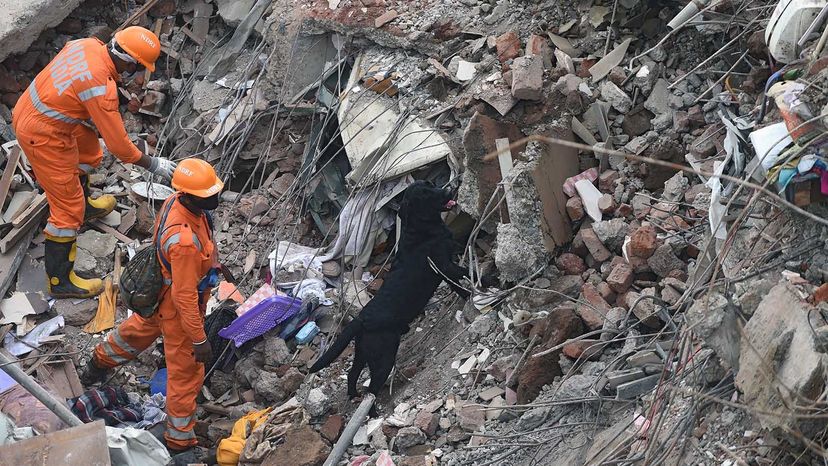SAR Specialties

Not all SAR dogs perform the same type of searches. Some dogs are tracking (or trailing) dogs, and others are air-scent (or area-search) dogs. The types overlap, but the distinction between the two guides are the training process and how the dog participates in missions.
Tracking dogs work with their noses to the ground. They can follow a trail of human scent — typically heavy skin particles that fall quickly to the ground or onto bushes — through any type of terrain. These dogs are not searching, they're following. Tracking dogs need a "last seen" starting point, an article with the person's scent on it to work from and an uncontaminated trail.
Advertisement
For a tracking dog, time is an issue. If a child disappears from a school playground or an inmate escapes from a prison, a tracking dog can be called in to follow the person's scent immediately after the disappearance, before other search groups and law-enforcement personnel contaminate the scent trail.
Air-scent dogs, on the other hand, work with their noses focused toward the air. They pick up human scent anywhere in the vicinity; they don't need a "last seen" starting point. Whereas tracking dogs follow a particular scent trail, air-scent dogs pick up a smell carried in air currents and seek out its origin — the point of greatest concentration.
Air-scent dogs might be called in to find a missing hiker located somewhere in a national park, an avalanche victim buried beneath the snow or people trapped under the rubble of a collapsed building. Air-scent dogs specialize in other types of searches, including:
- Cadaver: These dogs search specifically for the scent of human remains and are trained to detect the smell of human decomposition gasses in addition to skin rafts. Cadaver dogs can locate something as small as a human tooth or a single drop of blood.
- Water: Water rescue dogs search for drowning victims. When a body is under water, skin particles and gases rise to the surface, so dogs can smell a body even if it's completely immersed. Due to the movement of water currents, dogs can seldom pinpoint the exact location of the body. Instead more than one SAR team searches an area and divers use each dog's alert point, along with water-current analysis, to estimate the most likely location of the body.
- Avalanche: These highly trained dogs search for human scent after someone has been buried beneath the snow.
- Urban disaster: The most difficult SAR specialty, urban disaster dogs search for human survivors in the rubble of collapsed buildings. They must navigate dangerous, unstable terrain. More than 300 urban rescue dog/handler teams responded to the collapse of the World Trade Centers on Sept. 11, 2001.
- Wilderness: These dogs detect human scent in search of people lost in the wild.
- Evidence/article: Dogs highly trained to find items that have human scent on them.
In urban disasters, where people are trapped beneath precarious piles of debris, a dog's strength, confidence and agility are key. Even more important, though, is obedience: An out-of-control dog is a liability in search situations. This is where SAR standards come in.